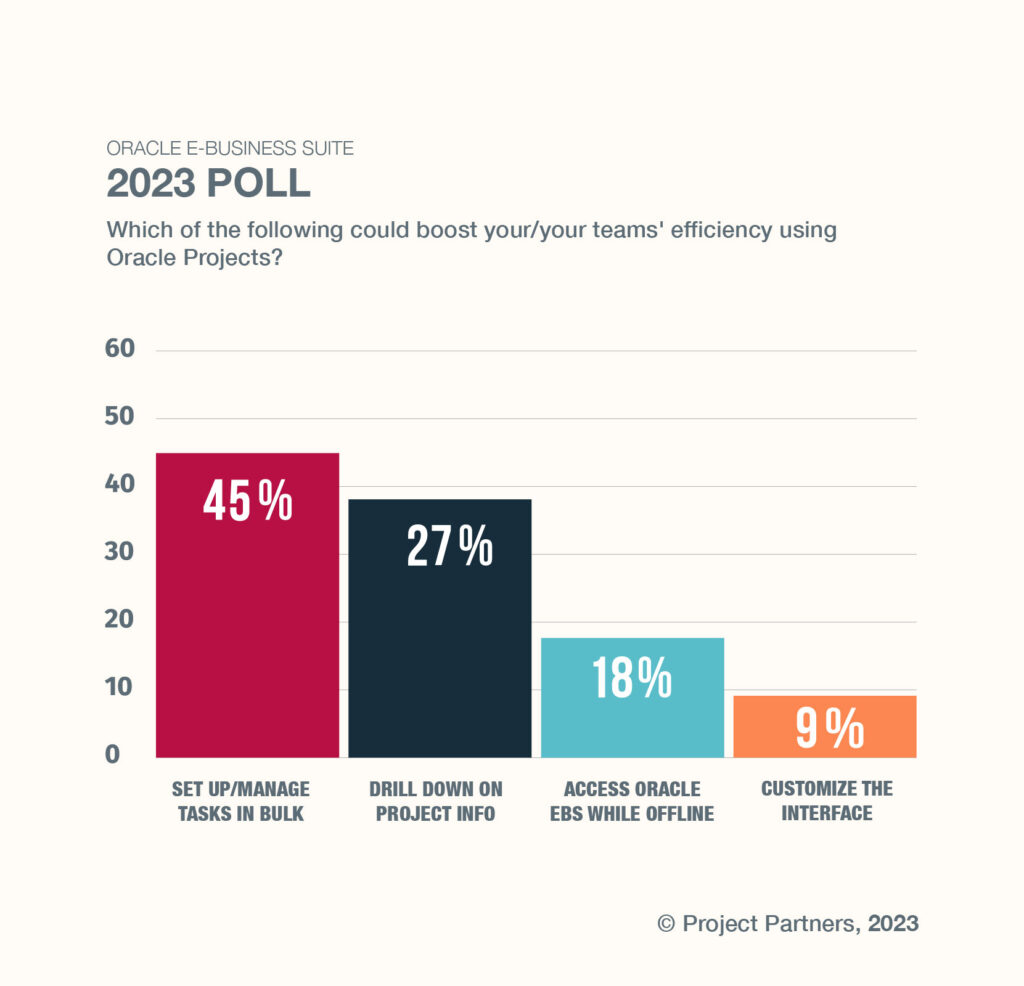Oracle E-Business Suite (EBS) – a leading Enterprise Resource Planning (ERP) platform – has evolved over the last 30 years to meet the ever-changing needs of project-centric organizations. The majority of business operations are supported by EBS, including:
- supply chain management
- financial and asset management
- human resources
- customer relationship management
- reporting
- sales & order management
As Oracle’s applications have matured, one focus area has been UX modernization to improve organizational productivity. Through our experience leading the development of Oracle Projects and hundreds of Oracle EBS implementations, our experts have uncovered even more ways to improve user experience.
10 ways to improve Oracle E-Business Suite’s utilization and effectiveness in project-based organizations:
1: Enable users to execute multiple project tasks simultaneously
Establish a task hierarchy of parent and children tasks with dependencies. Configure the task hierarchy before your projects begin so you can see and manage many project tasks at once, over multiple periods, rather than having to complete one task at a time. By implementing this methodology, organizations have seen a 65% increase in task productivity.
2: Customize the data you see based on your role
The Oracle EBS user interface can be customized to match the specific requirements of your project managers. Provide them access to only see the project data relevant to the projects they are managing. Not all project managers are the same – nor do they manage or report on the same project information.
3: Analyze project task data in detail!
Standardized Reporting is a standard function of EBS that gathers information and tasks associated with any given project. As costs accrue, EBS rolls all the costs into the period and summarizes the data for reporting. Expand the Standardized Reporting Function to review detailed information on specific project items. This allows your project managers to analyze and report on specific project-level information at any point of the project lifecycle with ease.
4: Plan your budgets and forecasts based on real-time project consumption
Generate Forecast is a complex program within EBS that takes your project information and forecasts how much work is left, how much budget is left, and how much more money is needed. In EBS, forecasts are periodically generated using Actuals (through prior and current periods) and the ETC (estimated time to complete) yields from the budget/forecast. However, you don’t bill at the end of your project; you bill along the way.
If there are significant variances between the budget and forecast, your teams can replan and adjust quickly before running over budget.
5: Collaborate on projects in real-time
Projects are living entities, needing current data to function well. In EBS, your team can easily add tasks, alter resource assignments or divide jobs while on the go, allowing project managers to regularly review and make adjustments. This way, the information you have will constantly be updated so everyone has access to the most current info during all project phases.
6: Make EBS work for you, not the other way around
ERP applications should work for your business requirements, not how your ERP suggests you should run your business. Access your business process and technologies to ensure your EBS instance works the way you need it to work. If you currently have EBS, there’s some good news! Oracle just announced that EBS 12.2 Premier Support is extended through at least 2034. There is no need to rush to cloud applications, but now is the time to map out what that might look like.
7: Visualize the status of your project
For visual measurement of project success, actionable task, and transaction data can be automatically configured in graphical and table formats. A complete Gantt view of the project schedule or Workplan can also be generated with original and current baselines, forecast dates, and percent complete information.
8: Ensure the interface is intuitive
Oracle’s UI has undergone many enhancements over the years, but it is still considered an advanced interface for non-technical users. User experience can be simplified to use familiar or common workflows.
9: Enable offline productivity
Often, project teams work remotely, with limited access to WIFI and cellular connectivity. Your team can download project task information securely to a local device and update project data on-site while the information is fresh. Information synchronizes with Oracle once the team is connected to the network again.
10: Enhance agility in your projects
Enable your teams to make decisions with real-time information in a role-based context. By ensuring information, market shifts, economic turns, resource availability, and other variables are no longer obstacles to overcome. The project lifecycle is dotted with obstacles that become just another stepping stone.
A Recent Poll
According to a recent poll conducted on LinkedIn, we asked our followers:
Calling all Project Managers and non-technical Oracle Users – we want to hear from you! Which of the following could boost your/your teams’ efficiency using Oracle Projects?

- Set up & manage tasks in bulk (45%)
- Drill down on project information (27%)
- Access EBS applications while offline (18%)
- A custom interface tailored for my role (9%)
Allow your teams to take control of the projects they are managing. With Project Partners’ User Interface Applications (UI-Apps), all of this and more is possible.
Want to see UI-Apps in action? HDR, a global AEC consulting firm, saved $4.8M annually in Oracle Projects workflow efficiencies: continue reading.